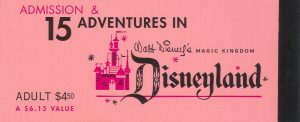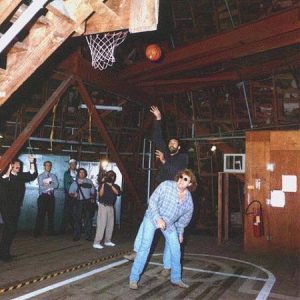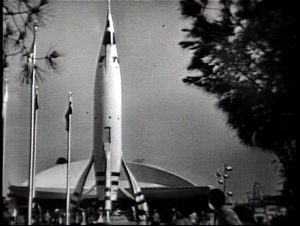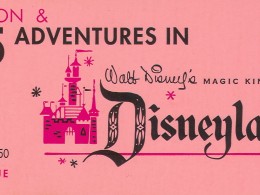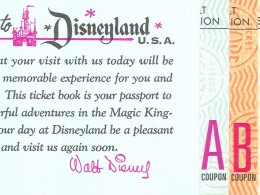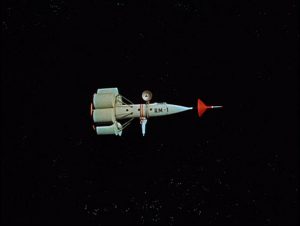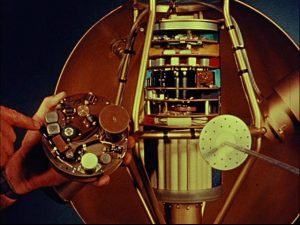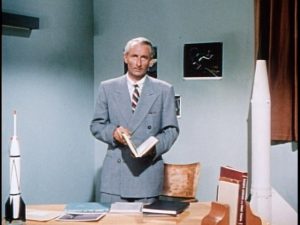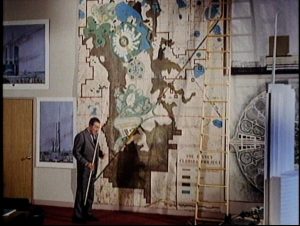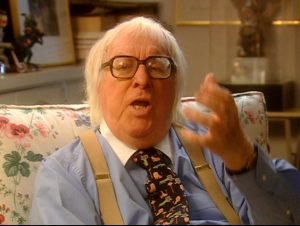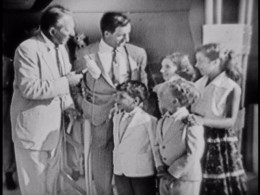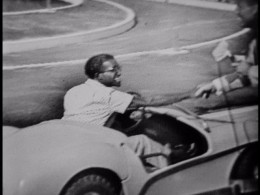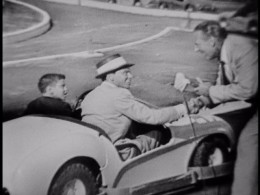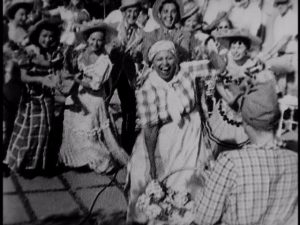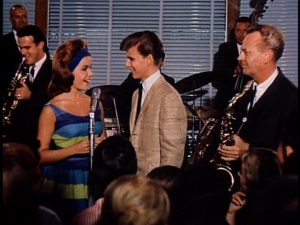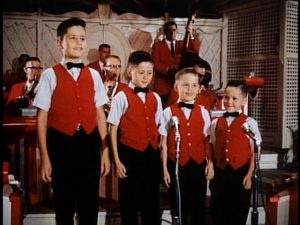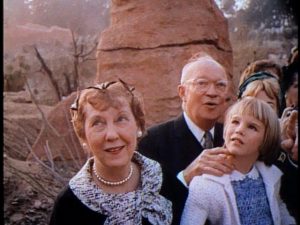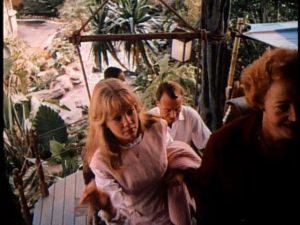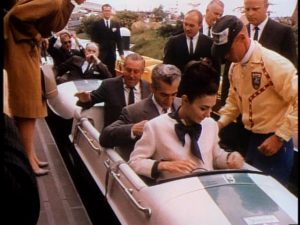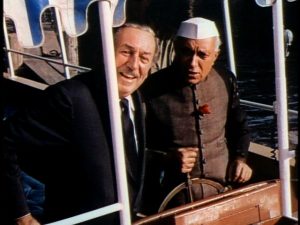In 2001 the Disney company released four sets of DVDs in metal boxes, called Walt Disney Treasures, and has been bringing them out yearly ever since, in what they refer to as “waves.” There are now seven waves. Each wave has three or four sets, and all of the sets contain 2 discs. Whew! That’s a lot of DVDs! Fifty (count ‘em, 50!) disks. They have appeared yearly in time for Christmas shopping, except that for some reason the 2003 wave didn’t come out until May of 2004.
There are basically four kinds of material on these sets, some of which overlap:
1) Archival collections of all the major Disney characters, presented chronologically. This includes some of the very early Alice comedies, and all the Silly Symphonies. They’ve thus far brought out all the Goofy and Pluto shorts, and they’re working their way through Mickey and Donald.
2) Episodes of “The Mickey Mouse Club” and “Disneyland,” which was the original title of the ongoing television series that first aired in 1954 and later became “Walt Disney’s Wonderful World of Color” in 1961 and “The Wonderful World of Disney” in 1969.
3) Disneyland-related material.
4) Very obscure stuff “from the vaults.” Disney Studios kept everything, unlike most other major studios and animators like Warner Brothers, and now it’s paying off. Some of it is very interesting.
Here’s a list of what’s come out so far:
Walt Disney Treasure: Wave One – December 4, 2001
• Mickey Mouse in Living Color
• Silly Symphonies
• Disneyland, USA
• Davy Crockett
Walt Disney Treasure: Wave Two – December 3, 2002
• Mickey Mouse in Black and White
• The Complete Goofy
• Behind the Scenes at the Walt Disney Studio
Walt Disney Treasure: Wave Three – May 18, 2004
• Mickey Mouse in Living Color, Volume 2
• The Chronological Donald
• On the Front Lines
• Tomorrow Land
Walt Disney Treasure: Wave Four – December 7, 2004
• Mickey Mouse In Black and White, Volume 2
• The Complete Pluto
• The Mickey Mouse Club
Walt Disney Treasure: Wave Five – December 6, 2005
• The Chronological Donald, Volume 2
• Disney Rarities: Celebrated Shorts, 1920s – 1960s
• The Adventures of Spin & Marty (The Mickey Mouse Club)
• Elfego Baca and The Swamp Fox: Legendary Heroes
Walt Disney Treasure: Wave Six – December 19, 2005
• More Silly Symphonies
• The Complete Pluto Volume 2
• The Hardy Boys: The Applegate Mystery
• Your Host, Walt Disney
Walt Disney Treasure: Wave Seven – December 11, 2007
• The Chronological Donald, Volume Three
• The Adventures of Oswald the Lucky Rabbit
• Disneyland: The Secrets, Stories and Magic
I only became aware of them recently, and was delighted to rent “On the Front Lines,” which contains patriotic wartime propaganda shorts, including some made to sell bonds for the Canadian government while the US still wasn’t in the war, and more traditional cartoons but with a wartime theme, like the Oscar-winning “Der Fuehrer’s Face.” The second disk contained what I was really looking for, the seldom-seen Victory Through Air Power, Walt’s attempt to get America to invest in long-range bombers. It also included a small selection of the educational shorts Disney made to train workers during the war, such as “Four Methods of Flush Riveting,” which is even less exciting than it sounds (“flush riveting” could be some sort of sexual reference, couldn’t it?), but is fascinating as an example of a new field coming into being.
But it was the 7th wave I knew I had to own. Not the first or second volumes (I wouldn’t mind owning the Donald discs if somebody gave them to me, but I’m not that interested in Oswald the Lucky Rabbit), but the third, which was behind-the-scenes Disneyland stuff. Here’s what I got:
Disneyland: Secrets, Stories and Magic. Wave 7, Set 4
class="title">Disc One"
Disneyland: Secrets, Stories and Magic of the Happiest Place on Earth. An 81 minute documentary of the park, produced in 2005 during the 50th anniversary of Disneyland. This was excellent, including the reminiscences of many of the people who had a hand in designing the original park
Wonderful World of Disneyland Trivia Game. Not all that much fun, because every time you missed an answer you had to go back and start over. We started out on the HARD setting, but soon switched it to EASY, and finally won!
People and Places: Disneyland U.S.A. This was one of Disney’s series of theatrical shorts, treating Disneyland as if it were a country, like Switzerland. Well, it is, isn’t it? Only more interesting, even cleaner, and without all those annoying Swiss.
class="title">Disc Two"
Operation Disneyland. A behind the scenes look at the preparations for the live broadcast of the opening of Disneyland, filmed for ABC affiliates to show them all the work that had been done to broadcast this massive event, one of the biggest live broadcasts ever up to that time. This was fascinating, a glimpse of 1950s television technology, which was pretty primitive. The cameras were massive and not all that reliable and they had to commandeer every ABC camera in the Southland and neighboring states, plus rent them from other stations. Everyone was knee-deep in cables, the control room was a sweatbox, there was no such thing as an outdoor camera dolly so they put them on forklifts … it was a mess, but came off pretty well.
The Golden Horseshoe Revue. An episode of “The Wonderful World of Color” featuring the “10,000th performance of The Golden Horseshoe Revue.” Aired on September 23, 1962. There is no way to describe this other than … lame. I’m sorry, but it was. And way beyond corny. It was presented as if they’d just filmed the show, but it was obviously edited and the “impromptu banter” with guest Ed Wynn was scripted. The acts were not funny, and the lighting was so harsh for the color cameras there were no shadows anywhere.
Disneyland Goes to the World’s Fair. An episode of “The Wonderful World of Color” featuring Disney’s presence at the 1964-65 New York World’s Fair. Aired May 17, 1964. This was one of the treasures for me. Driving from Texas to New York with a friend when we were 17 was the highlight of my life up to that point, and this sure did bring back memories. Moving dinosaurs in the Ford Pavilion! (Facing the GM Pavilion, like two giant, snarling monsters, with the Chrysler Pavilion in the middle!) Mr. Lincoln, which blew us away at the time: A real robot! The Unisphere! The GE Carousel of Progress, with robots singing “There’s a Great Big Beautiful Tomorrow!” And we believed it, didn’t we? Both Ford and GM had visions of gigantic cities simply teeming with cars … that moved! That weren’t stalled perpetually in smoggy freeway traffic! Oh, for yesterday’s tomorrows! … and … that song … in it’s a small world, Presented by Pepsi, … that song, playing over and over and over and over as we sat stalled in our tiny boat … oh, the horror, the horror … this episode takes you through the entire ride … oh, the horror …
Disneyland Around the Seasons. An episode of “The Wonderful World of Color.” Aired December 18, 1966. Deals mostly with moving the stuff from the World’s Fair and installing it in Disneyland, and a bit of a cheat, actually, because the footage from it’s a small world was the same stuff they used in the previous episode … that song, again. I fast-forwarded through that part.
There was “extra bonus material” included on the second disc: Building Walt’s Dream: Disneyland Under Construction. This was really amazing stuff. There is footage here of him tramping around in the orange groves, pacing off the dimensions of his dream. Walt was always looking forward, so he had temporary towers built all over the construction site and he put time-lapse cameras on them. Dozens of cameras, running all day long. There are literally hundreds of hours of this stuff, of buildings growing before your eyes, like flowers opening in his famous nature documentaries of that same time. This is a sampling of some of that vast historical treasure. The narration by two guys who were involved in the construction is full of tidbits:
Did you know that Sleeping Beauty’s Castle, the very symbol of Disneyland, was originally planned to face the other way? One day somebody picked up the model and turned it around, and said he liked it better that way. Walt did, too.
Did you know that the park took exactly one year to construct? These days, it takes four years just to add on Cars Land at California Adventure.
The iconic TWA Moonliner was delivered and set in place the day before opening!
Walt expected to build the whole park for a few million dollars, but he had a hard time stopping when he got another good idea, and he kept having them, so he had to go back to investors several times. Final price tag: $17,000,000. You can’t build even one ride there for that kind of money these days, of course.
Opening day was a disaster, as everyone knows. But Day Two, the lines were incredibly long, and it’s been that way ever since.
The box also included a reproduction of an ABCDE ticket book, which doesn’t say the year it’s from. But park admission was 90¢. The price of the ticket book was $4.50 (a $6.15 value!). “A” tickets were 10¢, “B” were 20¢, “C” 30¢, “D” 35¢, and an “E” ticket would set you back a whopping 50¢! “Just five thin dimes, folks, one half of a dollah! Step right up and ride the … go away, little boy, ya bother me.”
There are two other sets that are of interest to me, and I just located and ordered copies from Amazon for a bargain price, so I should be able to review them here before this segment is posted. They are: “Tomorrow Land,” and “Disneyland, USA.” I can hardly wait.
LATER: Hooray! They’ve arrived!
Tomorrowland: Wave 3, Set 4
class="title">Disc One"
Man in Space. “Tonight, from Tomorrowland …” Those were words that always thrilled my young heart … when I could hear them at all. The problem was, my family didn’t get a television set until rather later than most of my friends. So for a while there I had to go to somebody’s house to see “Disneyland,” and that could not always be arranged. Even worse, when we moved from Fort Worth to Port Arthur, Texas (I was starting the 2nd grade), there were only two television stations, and neither of them were ABC, so nobody was seeing the show until a third station went on the air. (Oh, some folks had real tall antennas and could, if the stars were right, pull in a Houston station, which looked like it was broadcasting from Mars in a blizzard.) So I didn’t get to see some of these episodes I now have on DVD until much later. But some of them were released theatrically. Remember the days when a trip to the movin’ pitchers involved a feature (maybe even two), a cartoon or two, a newsreel, and a short subject? (You don’t? Oh, poor you!) Some were sent around to schools and from time to time we’d have an assembly and get to see a Disney short or a science film from GE. (And the AV nerds would always manage to break the film at least twice. I think they just enjoyed splicing.) I saw some of this material in that way. “Man in Space” was first broadcast on March 8, 1955, which is pretty early in Disney’s television history. It stars those great American scientists Heinz Haber, Willy Ley, and Werner von Braun, who were going to get us into space pretty damn quick. Well, they did, didn’t they? Let’s just not think about all those V-2s landing on London. As Tom Lehrer sings: “‘Vunce zee rockets go up, who cares vere zey come down? Zat’s not my department,’ says Werner Von Braun.”
Once more being way ahead of the curve, Walt had these television episodes produced in color, even though color television was still a few years away from commercial reality. (Do you know what the first colors sets in the US cost? $1295, which is about $9400 in 2006 dollars! ABC and CBS dragged their feet on color—mostly because RCA made the color sets, and RCA owned NBC—so Walt switched to NBC, the all-color network, in 1961.) They were directed by Ward Kimball, who knew nothing about space or space travel, but was a good learner. Everything about these remarkable documentaries is scientifically accurate, which Hollywood SF movies were certainly not doing … still aren’t, for that matter. Things didn’t always happen the way they’re depicted here—we still haven’t built a rotating space station like the one here or in 2001: A Space Odyssey—but we could have, and, in fact, it would have made a lot more sense to do so. If we had, we might have established a permanent base on the moon with our very first landing in, say, the late 1970s or early 1980s, instead of going there a few times and then stopping. Damn space race! The all-time worst reason ever for going to the moon, and just about the only one science fiction writers never anticipated. It was too stupid …
Man and the Moon. First broadcast December 28, 1955. This is all Werner von Braun’s show. He’s on-screen, wooden as a Dutchman’s shoe, for much of the picture. He shows off the hardware he’s designed … and oh, did it take me back! Some model company in the 1950s (Monogram?) worked with Disney and created plastic models of the big booster rocket (the first stage had 29 engines!), the rotating space station, and the moon rocket itself. The moment I learned these things were available I knew I had to have them or die. Well, here I am, so you know I eventually got them. I can still smell the glue (we didn’t know sniffing it made you high, but I think it did, anyway) and feel my fingers sticking together and to some of the smaller parts. Those models figured in all my early science fiction stories, which me and a few friends made up as we went along. I found one for sale, just $90: Nuclear Powered Space Station. I also had this one: Mars Probe Landing Module; and this one: Space Station. Now they want $2100 for it! I think I paid around $1.98, which seemed like a fortune at the time.
Mars and Beyond. First televised on December 4, 1957. Like all the others, this one is narrated by the great Paul Frees, who must have done two dozen voices here. Like the others, it begins with Disney animators telling the history of observations and speculations on Mars. This stuff was designed to ease us into the hard science, and it is very, very well done. Funny and informative at the same time. The plan for the Mars expedition was huge, involving six large ships, all atomic powered. In fact, the moon ship and just about everything else proposed in these films (including jet aircraft!) are nuclear powered, which makes perfect engineering sense, but not political sense. Nobody seems to have worried about stuff like that circling over our heads, or more importantly, coming back down. And we’re not talking about the puny little power sources that we’ve used on planetary probes (and which were protested loudly, and ignorantly, by those to whom the word “atomic” might as well be “pedophilic”). These would have been serious nukes, things that, if they’d crashed in a city, would have meant everyone would have to move out. But then, the true perils of radioactivity were still imperfectly understood at that time … and/or the data had been suppressed by the government.
class="title">Disc Two"
Eyes in Outer Space. Was first released theatrically, in June 1959, and later showed up on “Disneyland.” And talk about your optimistic outlook! Not only did this explore the benefits to be gained by weather observation satellites, of which we had a few very primitive examples ready to go into orbit (here’s a picture of the “super-tiny” tape recorder that will store the data and send it back to the ground; the electronic package has transistors the size of peanuts!), but they were planning to control the weather! I remember there was a lot of talk of cloud seeding at that time. I don’t think anything ever came of it. Even if it were possible … can you imagine the lawsuits if anything went wrong? Hell, some fishermen’s families sued the government not long ago because a weather satellite went down and thus was unable to forecast a big storm that killed some people. What if they tried to steer a hurricane and it missed Miami, but hit the Carolinas? One more example of very bright engineering minds failing to think it through.
Nevertheless, the last half of this segment is devoted to a tense account of events inside a vast weather control center, where rockets from the ground and from space are fired into a hurricane and into a high pressure area they are attempting to move from Kansas to the Atlantic Coast, to block the storm. They do … and Kansas is drenched in torrential rain. Sorry about that, farmers … but they do succeed in diverting it! The narrator announces proudly that “The hurricane is left to spend itself harmlessly, far out to sea!” Well, actually, if you look at the map, it seems to be headed for England …
Our Friend the Atom, January 23, 1957. This was the heyday of optimism about atomic power, which was going to be used to power everything, and would be so cheap that electricity wouldn’t be metered; it’d be free! Like the Internet! Obviously no one reckoned on how expensive the plants would be, nor how much opposition—some informed and reasonable, some born of ignorance and panic—there would be. Nobody was thinking Three Mile Island or Chernobyl in those days.
But the beginning here is educational, exploring the nature of atoms and how everything about them came to be discovered. Naturally we start with Democritus, who first proposed the idea of tiny, indivisible particles, and came up with the name atom. Just as naturally we quickly go to Aristotle, who pooh-poohed it … and is it just me, but don’t you think Aristotle was the biggest fool who ever lived? I mean, was he ever right about anything? How many times in the history of science has this same thing happened? Somebody proposed something, but the great Aristotle pronounced that it was the other way … and he was always wrong!
This is all presented by Dr. Heinz Haber, a man who makes Werner Von Braun seem as warm and personable as Walt Disney by comparison, but he does a good job of steering us right through the history and into the concept of orbital electrons, which he says are like little planetary systems … which they are not, and he knew they are not, but nobody was ready for quantum mechanics in this sort of film. (We had to wait for that awful piece of crap What the Fuck Do We Know? for that.) The scene I remember most vividly is where they filled a room with mousetraps, each loaded with two ping pong balls, to illustrate the nuclear fission of the uranium atom. You toss one ball into the room, and in seconds you got a blizzard of neutrons/pongs. And of course you gotta wonder, how many times did it go off by accident?
Epcot. Here’s a treasure from the vaults, one of the best reasons for exhuming these dusty old things. It was made in October 1966 and though it’s been excerpted, it was only shown in its entirety to Florida legislators that Walt was trying to sell on this vast, amazing, impossible dream they were calling The Disney Florida Project. The company needed some zoning variations and things like that (and has since been roundly criticized from some quarters for the way they played fast and loose with state government, taxpayers, and I don’t know who all). But Walt was one hell of a salesman … and two months after this was shown, he was dead. Which was a shame for all sorts of reasons, but I just have to think that, had he lived, Epcot would be a very different place. He was the driving, creative force, and always was. There were plenty of other creative people around him, but none of them had the genius to build a new city from the ground up, which is what Epcot was supposed to be. The sheer will that created Disneyland when everybody was saying he was crazy was what was needed, and Walt was no longer there to provide it.
I’ve never been to Epcot, but it looks absolutely delightful. I’d love to go, and I’m sure I’d love every second of it when I got there. But what is it? It’s essentially a permanent World’s Fair. That is not what Walt had in mind. He shows it here in great detail, a planned community with high-density shops, businesses, apartments, even manufacturing in the center, with people movers connecting it all to radiating spokes of suburban housing, with monorails connecting to the outside world. People would have cars, but would use them only to go somewhere else. And they wouldn’t have done that often, as it would have been a self-contained organism, like an arcology but not as vast and not as dense and not as tall. These unitary towns could be strung together along the rail lines and eventually replace the old cities. What a vision!
Didn’t happen. Eventually Walt’s successors built Epcot in an entirely different way. They made a nod to his utopian community scheme with something called Celebration, Florida, but it’s nothing like Walt’s vision, it looks to me like just another suburban town full of McMansions. And, according to Wikipedia, 93.57% white.
Bonus Material
The Optimistic Futurist. An interview by Leonard Maltin with Ray Bradbury, who knew Walt during the last decades of his life and has a lot of interesting stories to tell about him and Disneyland.
Marty Sklar, Walt, and Epcot. Sklar has been head of Imagineering at Disney for a long, long time. He talks about Walt’s vision for Epcot and many other things. He said he suggested “Waltopia” as the name for the place. I got to thinking about that one, and came up with another possibility: “Distopia.” Er … not to be confused with dystopia … oh, never mind.
Disneyland USA: Wave 1, Set 3
class="title">Disc One"
The Disneyland Story. The very first episode of what would become the longest-running television anthology series ever (under several different titles): “Disneyland,” broadcast October 27, 1954. It’s largely a commercial and teaser for the park, which was still almost a year away. The rest of the show gives samples of the other fare that would be offered, such as an edited version of Alice in Wonderland. I’m sure this must have been very exciting to viewers, as before this not much that was released in theaters ever made it to the small screen, unless it was real old. Better yet, in the public domain. It wasn’t until 1961 that NBC Saturday Night at the Movies began bringing relatively recent color films to television.
Dateline Disneyland. Here’s the legendary live broadcast, of which I’ve only seen little clips here and there of the shows several hosts: Art Linkletter, Bob Cummings, and good ol’ Ronnie Reagan, looking like the pitchman he was. Leonard Maltin in his introduction says that 90 million viewers tuned in. Can that be true? I didn’t think there were anything like that many TV sets in America on July 17, 1955. Googling … ah, I was wrong.
There were 30 million sets in 1955. With three people watching per set, and nobody watching anything else (which I guess was pretty close to the case), it could be right.
We begin with someone named Hank Weaver, who is sitting at his typewriter and smoking a cigarette. Behind him are at least two other people smoking as they work. It’s sometimes hard to recall just how accepted smoking was before our super healthy era in which, I’m reliably informed, none of us is going to die of anything, if we just don’t consume any food or breathe any air. Glory hallelujah!
Statistics doled out by Linkletter: Disneyland cost $17,000,000. There are 29 cameras covering this event. The steamship Mark Twain cost a quarter of a million dollars. There are 15,000 invited guests, including:
- Danny Thomas & Family
- Sammy Davis Jr.
- Frank Sinatra & Jr.
Danny Thomas and his brood, including his eldest, Marlo, who looks genuinely thrilled to be going on the trip to the moon.
Frank Sinatra, riding in an Autopia car being driven by Frank Junior.
Sammy Davis, Jr., all alone in his car behind the Sinatras, in case they need any errands run, luggage carried, that sort of thing.
We go to Tomorrowland, where we learn that the year is 1986, “when a trip to the moon is an everyday thing!” Hell, that’s so far in the future, who knows? Maybe we can just buy a ticket in 1986! Didn’t you?
In Frontierland, who should come riding up but Davy Crockett hisself! My, are the kids excited! I mean, no kidding, before they were saying lines that had obviously been written for them, but now it’s genuine. That’s another hard thing to remember: just how much of a craze that whole shit-kickin’, cornpone, coonskin hat deal was. I only vaguely remember it, but I had my hat, you’d better believe it! And I could sing every verse of that pack of lies, “The Ballad of Davy Crockett.” Davy sings an ode to Betsey, his gun, about shooting b’ars, varmints, and injuns, whatever’s handy. If he’d made it to the West Coast he’d a probably been shootin’ him some Chinamen, too. Or am I being too cynical?
It was a different world, though. The only black people I saw other than Sammy were a few New Orleans buskers, doing what looked like a Stepin Fetchit loose-limbed shuffle, and … no kidding! … Aunt Jemima herself!
All the music was mimed, lip-synched, including the Firehouse 5 Plus 2, and a trumpet player up on a wrought iron balcony with three girls who look like … I’m sorry, Walt, but not to put too fine a point to it, they look like whores. Which would certainly be historically accurate in the French Quarter, but not what you expected to see at Disneyland.
Much has been made of what a disaster the first day was, and I’d expected the broadcast to be full of screw-ups. And as the day wore on, ice and food ran out and people began to swelter and it was awful. But aside from Linkletter having to go looking for a mike at one point, the TV show seemed to run pretty smoothly, considering. The video quality was dreadful, sometimes going almost completely to white … but that’s just how it was back then, kiddies. I know it’s hard to believe in these hi-def days, but most families back then had a designated rabbit-ears turner, whose job it was to stand by the furshlugginer TV set and turn the dadgum antenna when the picture started to go …
class="title">Disc Two"
Disneyland After Dark April 15, 1962. What a show! All the Disneyland magic, plus special guests. There’s little Annette … whoa! Annette’s not so little anymore, she’s filling out that bra more than a Mouseketeer really should! And who’s that with her? Why, it’s teen idol Bobby Rydell. Dude, that is some serious hair! Lend me your comb! And who’s that you’re channeling? Bobby Darin, of course, singing that lounge lizard jazz that has not weathered well. (And just between you and me, I don’t want to hurt her feelings, but Annette’s singing stinks. Everybody knows she sang “Tall Paul,” but did you know she also sang “Jo-Jo the Dog-Faced Boy”?
On to the dancers at the Tahitian Terrace, which was new at the time but isn’t there anymore. Replaced in 1993 by Aladdin’s Oasis Dinner Show. Then it’s aboard the Mark Twain where there’s an excellent New Orleans jazz band with Monette Moore and featuring Louis “Satchmo” Armstrong, singing and then blowing “Up a Lazy River.” Then they played the “Muskat Ramble,” and in the band on the trombone was Kid Ory, who wrote it! Wish I could have been there for that! Well, I know this was staged, but it could happen. I once saw the Buddy Rich band playing at the Carnation Plaza Gardens. And what’s happening at the Gardens? You ain’t gonna believe it, but it’s the Osmond Brothers! The oldest is 12 and the youngest, Jay, is 6. Donnie would be 4, Marie would be 2, and little Jimmie … well, he’s not even a bun in that fertile Mormon oven yet. They’re doing barbershop-type harmonies. Finally, a sing-along, and … good night, everybody!
Disneyland Tenth Anniversary Show January 3, 1965. Walt takes Julie, who has just been named “Miss Disneyland Tencennial,” an awkward name and an awkward woman, whose entire function is to stand around and smile while Walt explains things to her. He shows her models of the attractions being built as they speak, including it’s a small world, the Plaza Inn restaurant, the Haunted Mansion, and New Orleans Square, with the Blue Bayou Lagoon inside. Much of the Pirates ride is as we know it today, but some things they were thinking about never got included, such as a scene of a man walking the plank on the big pirate ship. (Wouldn’t have made much sense with a battle going on, would it?) There is a huge walk-through model of everything, where you follow the path the boats will eventually take. I can see that must have been useful in designing it. One thing that never materialized in the Haunted Mansion was the Museum of the Weird, which looks like it might have been fun.
Also part of the package is Walt bragging about some of the important people who have come to the park. We get to see some very weird sights, including:
Ike and Mamie Eisenhower on the Rainbow Caverns Mine Train.
Hayley and father John Mills at the Swiss Family Robinson Tree House.
- Mamie & Ike
- Hayley & John Mills
Jawaharlal Nehru at the helm of a Jungle Cruise riverboat, and …
The Shah and Empress of Iran riding with Walt on the Matterhorn Bobsleds! Is that surreal, or what?
- Shah of Iran
- Nehru
The culmination of all the festivities is a nice song and dance number with dozens of Disney Characters on the plaza in front of the castle.
class="title">Extra Bonus"
The Magic Kingdom and the Magic of Television. This is basically a rehash of what’s gone before, not worthy of being called an “extra.”
And there you have it, Disneyland lovers. A whole lot of stuff about my favorite theme park. Hope you learned something!
(By the way, there was obviously not much for Lee to take pictures of this time, so we’re adding illustrations that are screen captures from the DVDs. I think this comes under the fair use doctrine of copyright law, concerning reviewers. Unless somebody from Disney’s famously litigious legal department calls us on it, we will keep them up. Since we’re not using Mickey, I think we’ll be okay.)
June 6, 2008
Hollywood, California
© 2008 by John Varley; all rights reserved

